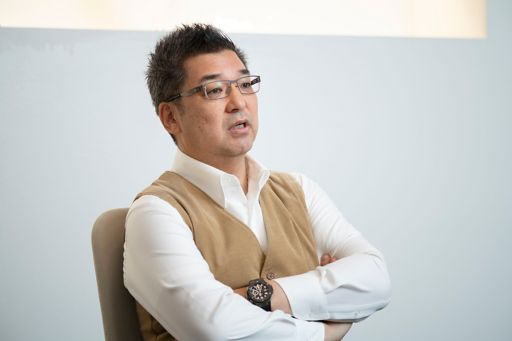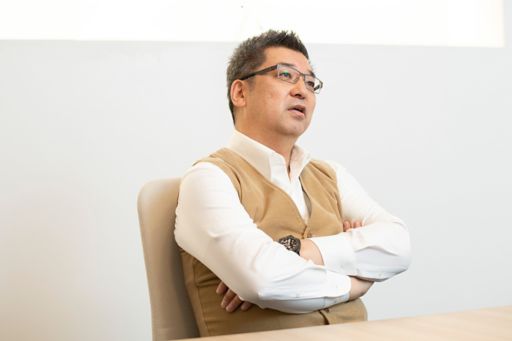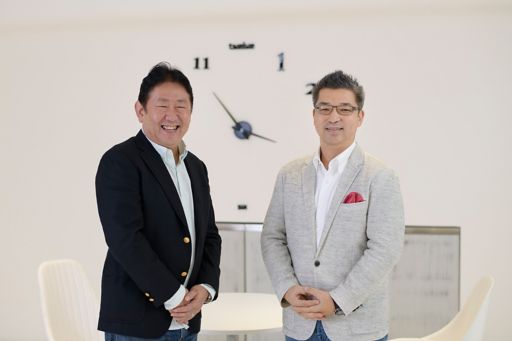In “What Is Digital Management as Defined by KPMG Ignition Tokyo?” I explained that data is essential for understanding that there are signs of discontinuous changes and possibilities of changes in tacit knowledge, which has not become an empirical value, and that it is therefore important to implement digital management in this age when our entire society is changing rapidly.
However, this way of thinking may be seen as the “defensive stance of the new normal.” It may be possible to think that after we go a step further from there and realize that we can go beyond the bounds of common sense, society will rapidly expand by fantasizing the future with unfettered thoughts, having visions such as “it would be great if this could be done!” and implementing matters that must be incorporated now from these visions.
In this way, Masayuki Chatani will explain how “ambitious” digital management should be and how to have awareness to realize fantasy-. vision- and implementation-driven digital management.
Contents
- Technology Will Become the Wings to Expand the World
- Significance of Vision- and Fantasy-driven Management
- Vision-driven, Fantasy-driven and “KKD (Intuition, Experience and Courage)” Are Different
- Age When Relationships between Companies Will Be Valued Will Come
- Fantasy- and Vision-driven Ideas will Guide Us to What Must Be “Implemented”
Technology Will Become the Wings to Expand the World

(Masayuki Chatani, Representative Director & CEO of KPMG Ignition Tokyo and CDO of KPMG Japan) *Professional affiliation and official position in the article are at the time of publication.
――Mr. Chatani, I understand that you have been involved in digital-based businesses since you started working. On the other hand, there seem to be many business people that feel an aversion when they hear the words “digital” and “technology.”
Meanwhile, some people seem to be baffled by terms like digital transformation (DX), AI and PRA being touted. For Mr. Chatani, who is a born and bred digital native, what made you think that “digital and technology are interesting?”
Chatani: I learned about computers in “My Computer,” a famous Bluebacks series book, when I was in junior high but the first time I actually touched a computer, I think, was when I was in the second year of high school. It was a calculator sold by Canon at the time. It was my physics teacher who taught me that “computers are very interesting.” We were able to draw a two-dimensional curve or rectilinear graph by inputting a mathematical formula, which was quite innovative at the time. I can still remember this teacher saying, “the age of such technology will come in the future.”
I had liked technology from before this time, when I was in elementary and junior high. I liked to fiddle with shortwave radios and used to listen to overseas radio services with Sony’s shortwave radio. When I was in the second grade of junior high school, I also bought a radio, which was like a communication device, and listened to overseas radio services.
Shortwaves can only transmit where the earth’s ionosphere is thick, in other words, the night areas. Therefore, in the evenings in Japan, it was easier to listen to the radio from South America, which is in the morning. Thanks to technology, radio programs in Spanish and Portuguese with Southern American accents and refreshing morning music were delivered to Japan from South America.
On a side note, as Sony had close to a 100% share of the broadcasting equipment market at the time, I came to dream of “working at Sony!” I also did some research and went to Osaka University, choosing the Department of Electricity, based on a very immature, high school student-like idea that “Sony may take me in if I graduate from the university where the president graduated from.”
What I learned at the university did not help much when I started working but there are now situations where I feel it is useful. For instance, my studies on quantum mechanics and optical fibers have enabled me to understand quantum computing and photonic technology, respectively.
As technology and digital were already becoming disseminated around us at the time, you will probably always find technology and digital in the background of what you casually take an interest in now. If this can serve as an opportunity for you to think, “I’m actually making good use of it already,” I think that many people will be able to enjoy and feel more familiar with digital and technology.
Significance of Vision- and Fantasy-driven Management
――I believe that Mr. Chatani has opened up an “unknown world” through technology and digital. I felt that this leads to vision- and fantasy-driven management.
Chatani: For a long time, “vision-driven” was said to mean ideas with which we can expand our vision that “it would be great if such a thing can be realized!” Whether it is a vision or fantasy, the reason why it is necessary is that if you build logic in a normal way, everyone will almost come to the same answer in most cases, so it will not lead to a source of competitiveness or differentiation. It is therefore important to create a difference by adding vision and fantasy.
I often use this example but when top soccer players are trapped, they sometimes choose to sweep the ball past a narrow space where the ball “normally will not come.” I think the player sees an image in his head, which can either be a vision or a fantasy, that “the defensive player will not think that the ball will come this way.”

I think this difference in the “sense of distance” the player sees determines whether it will succeed or not. In other words, in the simulation in his head, he sees that it will succeed but to the other players and the audience, it will seem like a vision or fantasy, which cannot be called realistic. However, because this happens in real life, it creates sensations and surprises. The reason for this difference is possibly the difference in each person’s “ability to see the future.”
The way people see reality, visions and fantasies differs according to the “visual ability” of the person who is trying to see them. The ability to see in a dynamic range, whether it is far or near, will become important going forward.
Unless the company looks at immediate issues and carries out bench tests by imagining changes in business models and further changes that will occur in a chain-reaction going forward, they will not be regarded as “implementing management.” It may also be necessary to perform simulations to ensure further accuracy. Taking this into consideration, there may be a demand for a management simulator for executives!
Vision-driven, Fantasy-driven and “KKD (Intuition, Experience and Courage)” Are Different

――Listening to what you said, it seems that vision-driven, fantasy-driven and “KKD (intuition, experience and courage)” are different. I think it is important to understand the difference. Can you tell us a little more about this?
Chatani: Of course. This relates to the “ability to see the future”, which I mentioned earlier, but I would like to talk about when Akio Morita, the co-founder of Sony Corporation, established “Sony Prudential Life Insurance (currently Sony Life Insurance)”, a joint venture between Sony and The Prudential Insurance Company of America.
In reaction to this decision made by Mr. Morita, some of the management team asked “Why do this? We are an electric equipment maker.” It is said that Mr. Morita persuaded them by saying that “if anything happens to Sony, this company will do us good for sure.”
In fact, when electric appliances were on a downward trend, it was Sony Insurance and Sony Interactive (PlayStation®️) that supported the group.
I think that Mr. Morita had a vision of the future that “electric equipment businesses will not last forever and it will be financial services that will help us at that time.” This outlook is not intuition but something like a conviction that “it would be nice if we had this.”
Akio Morita of Sony and Soichiro Honda of Honda Motor belong to the generation that continued to think “something must be done!” from when everything was lost after the war. I think they always thought more about the future than about that moment.
Steve Jobs, the co-founder of Apple, also used to write down ideas about technology that might attract attention in the future and marked “the ones that may come this year” every year. He must have always thought about how he could commercialize technologies that had become “ready”, from among the ideas he had envisioned or fantasized.
I don’t think he was acting on a whim but was constantly checking his lists and the progress of the evolution of technology. An example would be facial recognition, which was unfeasible three years ago, but has now been realized.
Though it may be necessary to consider changing the base technology in line with the trend in some industries, it is important not to ignore vision and fantasy and believe that they can “surpass common sense.”
After all, creativity and inspiration are essential for management. Simply put, the “intuition” aspect is indispensable for executives and it can be said that management can be performed because of intuition.
From now, executives will probably be required to possess a scientific ability that can interpret and utilize data, and an artistic ability as well. Laws of natural science such as the laws of physics may be found by someone someday, but art works such as Picasso’s paintings and Mozart’s music have to be created first. I think that this is what will be incorporated in the management approach in the post-COVID-19 era.
Age When Relationships between Companies Will Be Valued Will Come
――I feel that fantasy-driven or vision-driven is one of the processes for realizing dreams and future visions. In the case of business, there may be scenes in the process of realization where one may think “we can’t do it but maybe we can if we collaborate with others.”
Chatani: Until now, there has been a strong tendency among Japanese companies to achieve something within the group or industrial conglomerate. However, in recent years, this has been changing toward new inventions and plans being implemented through open innovation. Loose coupling (expandable) collaboration will become all the more important going forward.
What is necessary at such times is the awareness to “believe in others who are not you or your company.” Otherwise, it will be too frightening to establish collaboration.

Major companies carry out due diligence, whether it is in-depth or not, of the companies they will be collaborating with. However, if the other party is a venture company, there may be cases where they are determined to have an extremely low evaluation because “their technical capabilities are real but they still don’t have fixed assets,” for example.
It is necessary to conform to compliance but depending on the situation, we need to be conscious that there are cases where nothing will start unless we can say “yes, let’s work together” with companies that had been turned away before.
Due diligence is being practiced even in the U.S. where collaboration between companies is active. However, they are making innovations by skillfully using external networks while considering the depth of collaboration in stages. I think this will be a useful reference for us.
I feel that Japanese companies are too conscious about compliance on the whole that they are losing their grip in some areas. It may be necessary to recognize that things will not go anywhere if we only accept companies that have absolutely no problem.
Also, in an environment like Japan where the mobility of human resources is extremely low with no outsiders coming in, there is almost no experience of cultural mixtures and there may be cases where there are actually mistakes such as “it is correct on the account ledger but the process is wrong.”
Based on the above, it may be necessary to reconsider if past rules and company rules are really correct.
Fantasy- and Vision-driven Ideas will Guide Us to What Must Be “Implemented”

――While we must promote digitalization and technology with “fantasy- and vision-driven” ideas, there may be situations where digitalization may not necessarily be the optimum resolution, considering the resilience of the entire society in Japan, which has suffered many natural disasters. How do you think we can resolve this?
Chatani: What is interesting at companies where digital management is advanced is that when the network goes down, everyone suddenly stands up, walks around and starts talking directly with colleagues and team members. This can’t be helped because digital technology will stop without a power supply and there are not many companies that have generators or secondary batteries on each floor (laughs).
Furthermore, it may be that discussions on resilience may still be lacking in Japan overall.
While the use of digital currencies has been promoted in recent years, there are always several percent of people in Japan who are living in shelters. As it is a country with many natural disasters, it may be difficult to think that we can completely digitalize our life. Digital currencies themselves are not bad but I think the schemes of existing digital currencies do not have sufficient resilience.
At the time of the Great East Japan Earthquake, it is said that local financial institutions implemented emergency measures quite flexibly so that people could withdraw their money. It will be necessary to enhance resilience while considering the social system and the enhancement of laws and frameworks including the above occasion where “processes are not necessarily carried out digitally.”
It is of course necessary to find out the “digital and technology that must be implemented” that is lacking now in the process of pushing things toward “fantasy- and vision-driven” ways. At the same time, it is also necessary to find alternatives that suit Japan.
It is extremely important to disseminate digital technologies at the present stage but when digital becomes native (common), I hope to fantasize and envisage what kind of solutions and schemes can be provided to society where issues cannot be resolved by digital technologies alone.
Follow us on KPMG Ignition Tokyo LinkedIn for the latest news.
Connect with us
- Find office locations kpmg.findOfficeLocations
- kpmg.emailUs
- Social media @ KPMG kpmg.socialMedia




